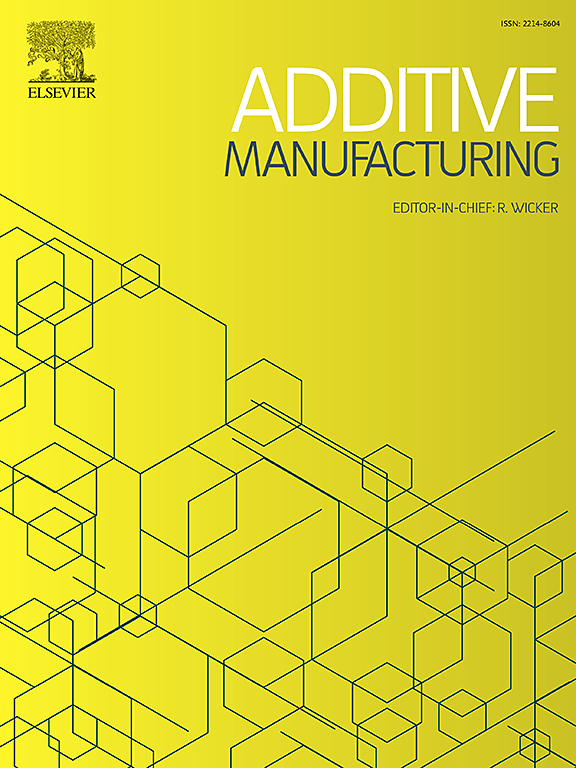Stiffness and strength enhancement of hierarchical TPMS-based shell lattices via inter-level conformal design
IF 11.1
1区 工程技术
Q1 ENGINEERING, MANUFACTURING
引用次数: 0
Abstract
Hierarchical structures in nature provide a blueprint design principle for engineering advanced lattice structures with enhanced mechanical properties and multifunctional performance. However, traditional Boolean-operation-based hierarchical lattices with incomplete second-level lattice structures at the boundaries, often suffer from localized deformation and stress concentration, limiting their stiffness and strength. Here, we introduce an inter-level conformal design for constructing hierarchical shell lattices that exhibit superior mechanical properties. By integrating a parameterized Monge patch model with iso-parametric transformation techniques, we achieve geometric conformity across multiple hierarchical levels. Numerical simulations with experimental validation reveal that inter-level conformal hierarchical triply periodic minimal surface (TPMS) shell lattices outperform their non-conformal Boolean-operation-based counterparts in stiffness, strength, and specific energy absorption by 28.4 %, 47.3 %, and 48.1 %, respectively. Such performance enhancement stems from the inter-level conformal design, which eliminates structural discontinuities and geometric truncations, prevent degrading the mechanical performance and introducing deadweight. Additionally, inter-level conformal architectures mitigate anisotropy, resulting in lower anisotropic Zener and Poisson's ratios. A statistical analysis of deformation mechanisms in hierarchical TPMS-based lattices reveals that both inter-level conformal and non-conformal designs exhibit a Weibull distribution of deformation behaviors. Notably, inter-level conformal designs are effective to reduce the stress localization, resulting in higher mechanical performance. These findings highlight the potential of inter-level conformal hierarchical design in enhancing the stiffness and strength of lattice structures, offering new opportunities for the design of high-performance lattice metamaterials across diverse engineering applications.
通过层间保形设计提高分层tpms壳格的刚度和强度
自然界的层次结构为工程高级晶格结构提供了一种蓝图设计原则,使其具有更高的力学性能和多功能性能。然而,传统的基于布尔运算的分层晶格在边界处具有不完整的二级晶格结构,往往存在局部变形和应力集中,从而限制了其刚度和强度。在这里,我们介绍了一种层间保形设计,用于构建具有优越力学性能的分层壳格。通过将参数化蒙日补丁模型与等参数变换技术相结合,实现了多层次的几何一致性。具有实验验证的数值模拟表明,层间共形分层三周期最小表面(TPMS)壳格在刚度、强度和比能吸收方面分别比非共形布尔运算的壳格高出28.4 %、47.3 %和48.1 %。这种性能的提高源于层间保形设计,它消除了结构不连续和几何截断,防止了机械性能的下降和自重的引入。此外,层间共形结构减轻了各向异性,导致各向异性齐纳和泊松比降低。通过对分层tpms晶格变形机制的统计分析,揭示了层间共形和非共形设计的变形行为均呈现威布尔分布。值得注意的是,层间共形设计可以有效地减少应力局部化,从而提高力学性能。这些发现突出了层间共形分层设计在提高晶格结构刚度和强度方面的潜力,为跨各种工程应用的高性能晶格超材料的设计提供了新的机会。
本文章由计算机程序翻译,如有差异,请以英文原文为准。
求助全文
约1分钟内获得全文
求助全文
来源期刊

Additive manufacturing
Materials Science-General Materials Science
CiteScore
19.80
自引率
12.70%
发文量
648
审稿时长
35 days
期刊介绍:
Additive Manufacturing stands as a peer-reviewed journal dedicated to delivering high-quality research papers and reviews in the field of additive manufacturing, serving both academia and industry leaders. The journal's objective is to recognize the innovative essence of additive manufacturing and its diverse applications, providing a comprehensive overview of current developments and future prospects.
The transformative potential of additive manufacturing technologies in product design and manufacturing is poised to disrupt traditional approaches. In response to this paradigm shift, a distinctive and comprehensive publication outlet was essential. Additive Manufacturing fulfills this need, offering a platform for engineers, materials scientists, and practitioners across academia and various industries to document and share innovations in these evolving technologies.
 求助内容:
求助内容: 应助结果提醒方式:
应助结果提醒方式:


